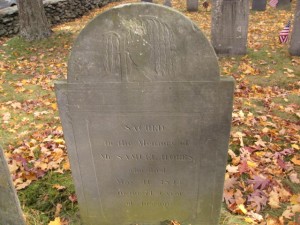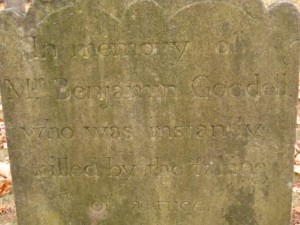I always look forward each October to receiving the schedule of events for Walktober, the month-long celebration of nature and history in the communities comprising the Last Green Valley, a federally-designated National Heritage Corridor. This year I promised myself I’d attend at least one of the walks, so just after 1 pm on this crisp, sunny autumn afternoon I headed south on 148 to Route 20 east to 131 south to Sturbridge Center.
Around 35 of us crowded into a basement meeting room at Sturbridge’s Joshua Hyde Library to hear a presentation on the Old Burial Ground at Sturbridge, by Joe Ouellette, a member of the Sturbridge Historical Commission and board member of the Last Green Valley. First, Mr Ouellette told us a little bit about what life was like in Sturbridge during the colonial period. In 1776, Sturbridge, with a population of 1,374, sent 132 men to serve in the Revolutionary War, most of whom were “short term call-ups.” The town was largely agricultural, with most households producing their own food, candles, soap, and clothing; swine were permitted to roam at large. Consider also these facts:
- There was little separation of church and state
- 10% of the population owned 35% of the land; 13% owned no land at all
- Women could not vote, hold public office, or own land (unless widowed)
- Slavery was legal
- Travel was slow; people walked, or if they could afford one, they rode horses
- There was no indoor plumbing and hardly any privacy in individual homes
- One child in three died in his or her first year; a child had a 50% chance of surviving until adulthood
- There was no anesthesia for surgery, and deaths from diseases such as pneumonia or malaria were common
So what do we know of individual lives in Sturbridge from this time period? Fortunately, we have written records of births, marriages, and deaths, and we also have the gravestones in the Sturbridge Burial Ground. By decoding the inscriptions on these markers, we can construct a social history of the town and also come to understand a bit more about what life was like for the early settlers. For example, we can corroborate statistics on infant mortality by observing the prevalence of children’s tombstones. Many are buried here; names like “Silence” and “Submit” may indicate a still-birth. As was noted above, women’s roles were largely confined to daughter, wife, mother; consequently, they are referenced on their stones to their fathers and husbands. A carving of a broken column or tree stump on a man’s tombstone probably indicates that he was a provider in the prime of life when he was stricken.
Some family names on the headstones will seem familiar to anyone with a passing acquaintance with the town and its history: Deneson, Wheelock, Plimpton, Hobbs, Fisk, Fiske, Shumway, Newell, Streeter are some of these. Many of these families produced distinguished citizens who served the town, the Commonwealth, and the nation. They were farmers, soldiers, millers, clerks, tanners, constables, town selectmen, innkeepers, and, of course, some were drunks. Mr Ouellette provided short biographies of many of these men and women, and then shortly before 3 pm, we all walked across Main Street to wander at will among the graves.
There is a location index to help you find a stone if you know the deceased’s name, but I didn’t consult it. The burial ground is not that large, and on my own I stumbled upon quite a few interesting tombstones which I photographed for you.

The stone wall enclosing the burial ground was built in 1794. The gates were given to the town by Mrs J Fiske in 1920.

In Colonial America, the popularity of the weeping willow motif on tombstones probably derived from the interest in classical mythology (the Founding Fathers were well-versed in the classics).

The marker next to the tombstone indicates that the deceased was a veteran of the Revolutionary War. The urn motif was also very popular in the early nineteenth century.





